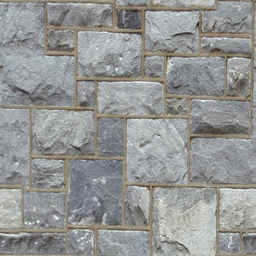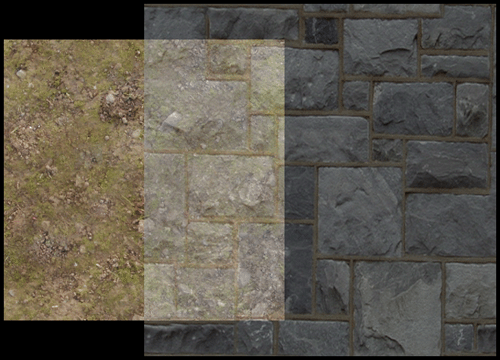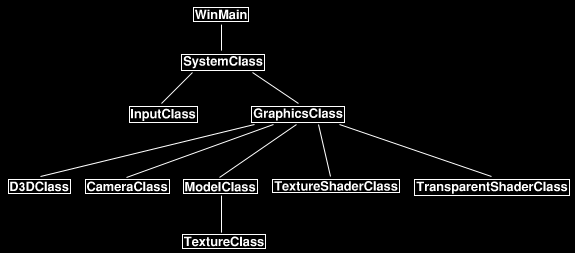DirectX 10 教程26:透明
原文地址:Tutorial 26: Transparency(http://www.rastertek.com/dx10tut26.html)。
源代码下载:dx10tut26.zip。
Transparency效果可以让一张带纹理的对象呈现透明效果。
例如下列一张纹理:

我们可以让此纹理半透明显示在另一张纹理上面,获得如下图所示的效果:

透明是使用alpha混合实现的。任意像素的alpha分量用于确定像素的透明程度。例如,一个像素的alpha值为0.5,则它会以半透明显示。许多纹理都有一个alpha分量,修改这个分量可以让纹理某些部分透明,某些部分不透明。
要让alpha值起作用,你必须首先在shader中打开alpha混合并设置混合方程。本教程使用的混合状态如下所示:
BlendState AlphaBlendingOn { BlendEnable[0] = TRUE; DestBlend = INV_SRC_ALPHA; SrcBlend = SRC_ALPHA; };
DestBlend用于目标颜色,它是该像素已经存在的颜色。我们使用的混合方程中将目标颜色设置为INV_SRC_ALPHA,即取源颜色的反相,即用1减去源颜色的alpha值。例如,如果源的alpha为0.3,则目标的alpha为0.7,这会将70%的目标像素颜色组合到最终颜色中。
SrcBlend用于源像素颜色,即本教程中输入的纹理颜色。混合方程用的是SRC_ALPHA,即源颜色乘以自己的alpha值。
源颜色和目标颜色值会叠加在一起生成最终的输出颜色。
框架
框架中新添了一个名为TransparentShaderClass的新类,这个类类似于TextureShaderClass,只不过多了一个alpha混合值。

Transparent.fx
//////////////////////////////////////////////////////////////////////////////// // Filename: transparent.fx //////////////////////////////////////////////////////////////////////////////// ///////////// // GLOBALS // ///////////// matrix worldMatrix; matrix viewMatrix; matrix projectionMatrix; Texture2D shaderTexture;
新添的变量blendAmount表示纹理的透明程度。
float blendAmount;
///////////////////
// SAMPLE STATES //
///////////////////
SamplerState SampleType
{
Filter = MIN_MAG_MIP_LINEAR;
AddressU = Wrap;
AddressV = Wrap;
};
新添的alpha混合状态用来实现透明效果。
/////////////////////
// BLENDING STATES //
/////////////////////
BlendState AlphaBlendingOn
{
BlendEnable[0] = TRUE;
DestBlend = INV_SRC_ALPHA;
SrcBlend = SRC_ALPHA;
};
//////////////
// TYPEDEFS //
//////////////
struct VertexInputType
{
float4 position : POSITION;
float2 tex : TEXCOORD0;
};
struct PixelInputType
{
float4 position : SV_POSITION;
float2 tex : TEXCOORD0;
};
////////////////////////////////////////////////////////////////////////////////
// Vertex Shader
////////////////////////////////////////////////////////////////////////////////
PixelInputType TransparentVertexShader(VertexInputType input)
{
PixelInputType output;
// Change the position vector to be 4 units for proper matrix calculations.
input.position.w = 1.0f;
// Calculate the position of the vertex against the world, view, and projection matrices.
output.position = mul(input.position, worldMatrix);
output.position = mul(output.position, viewMatrix);
output.position = mul(output.position, projectionMatrix);
// Store the texture coordinates for the pixel shader.
output.tex = input.tex;
return output;
}
////////////////////////////////////////////////////////////////////////////////
// Pixel Shader
////////////////////////////////////////////////////////////////////////////////
float4 TransparentPixelShader(PixelInputType input) : SV_Target
{
float4 color;
// Sample the texture pixel at this location.
color = shaderTexture.Sample(SampleType, input.tex);
我们使用blendAmount变量设置纹理的透明程度,将像素的alpha值设置为这个变量,当绘制时就会使用alpha值和混合状态创建透明效果。
// Set the alpha value of this pixel to the blending amount to create the alpha blending effect. color.a = blendAmount; return color; }
在technique中使用SetBlendState开启混合状态。注意这个混合状态会一直开启直到在关闭为止,因此使用其他shaer前需要关闭这个状态。
////////////////////////////////////////////////////////////////////////////////
// Technique
////////////////////////////////////////////////////////////////////////////////
technique10 TransparentTechnique
{
pass pass0
{
SetBlendState(AlphaBlendingOn, float4(0.0f, 0.0f, 0.0f, 0.0f), 0xFFFFFFFF);
SetVertexShader(CompileShader(vs_4_0, TransparentVertexShader()));
SetPixelShader(CompileShader(ps_4_0, TransparentPixelShader()));
SetGeometryShader(NULL);
}
}
Transparentshaderclass.h
TransparentShaderClass只是TextureShaderClass的改编版本,只是添加了处理透明的代码。
////////////////////////////////////////////////////////////////////////////////
// Filename: transparentshaderclass.h
////////////////////////////////////////////////////////////////////////////////
#ifndef _TRANSPARENTSHADERCLASS_H_
#define _TRANSPARENTSHADERCLASS_H_
//////////////
// INCLUDES //
//////////////
#include <d3d10.h>
#include <d3dx10.h>
#include <fstream>
using namespace std;
////////////////////////////////////////////////////////////////////////////////
// Class name: TransparentShaderClass
////////////////////////////////////////////////////////////////////////////////
class TransparentShaderClass
{
public:
TransparentShaderClass();
TransparentShaderClass(const TransparentShaderClass&);
~TransparentShaderClass();
bool Initialize(ID3D10Device*, HWND);
void Shutdown();
void Render(ID3D10Device*, int, D3DXMATRIX, D3DXMATRIX, D3DXMATRIX, ID3D10ShaderResourceView*, float);
private:
bool InitializeShader(ID3D10Device*, HWND, WCHAR*);
void ShutdownShader();
void OutputShaderErrorMessage(ID3D10Blob*, HWND, WCHAR*);
void SetShaderParameters(D3DXMATRIX, D3DXMATRIX, D3DXMATRIX, ID3D10ShaderResourceView*, float);
void RenderShader(ID3D10Device*, int);
private:
ID3D10Effect* m_effect;
ID3D10EffectTechnique* m_technique;
ID3D10InputLayout* m_layout;
ID3D10EffectMatrixVariable* m_worldMatrixPtr;
ID3D10EffectMatrixVariable* m_viewMatrixPtr;
ID3D10EffectMatrixVariable* m_projectionMatrixPtr;
ID3D10EffectShaderResourceVariable* m_texturePtr;
新添一个指向shader中blendAmount变量的指针。
ID3D10EffectScalarVariable* m_blendAmountPtr; }; #endif
Transparentshaderclass.cpp
////////////////////////////////////////////////////////////////////////////////
// Filename: transparentshaderclass.cpp
////////////////////////////////////////////////////////////////////////////////
#include "transparentshaderclass.h"
TransparentShaderClass::TransparentShaderClass()
{
m_effect = 0;
m_technique = 0;
m_layout = 0;
m_worldMatrixPtr = 0;
m_viewMatrixPtr = 0;
m_projectionMatrixPtr = 0;
m_texturePtr = 0;
在类构造函数中将blend amount指针设置为null。
m_blendAmountPtr = 0;
}
TransparentShaderClass::TransparentShaderClass(const TransparentShaderClass& other)
{
}
TransparentShaderClass::~TransparentShaderClass()
{
}
bool TransparentShaderClass::Initialize(ID3D10Device* device, HWND hwnd)
{
bool result;
加载transparent HLSL shader文件。
// Initialize the shader that will be used to draw the triangle.
result = InitializeShader(device, hwnd, L"../Engine/transparent.fx");
if(!result)
{
return false;
}
return true;
}
void TransparentShaderClass::Shutdown()
{
// Shutdown the shader effect.
ShutdownShader();
return;
}
Render方法中新添了一个类型为float的blend参数,它设置了纹理的透明程度。
void TransparentShaderClass::Render(ID3D10Device* device, int indexCount, D3DXMATRIX worldMatrix, D3DXMATRIX viewMatrix,
D3DXMATRIX projectionMatrix, ID3D10ShaderResourceView* texture, float blend)
{
// Set the shader parameters that it will use for rendering.
SetShaderParameters(worldMatrix, viewMatrix, projectionMatrix, texture, blend);
// Now render the prepared buffers with the shader.
RenderShader(device, indexCount);
return;
}
bool TransparentShaderClass::InitializeShader(ID3D10Device* device, HWND hwnd, WCHAR* filename)
{
HRESULT result;
ID3D10Blob* errorMessage;
D3D10_INPUT_ELEMENT_DESC polygonLayout[2];
unsigned int numElements;
D3D10_PASS_DESC passDesc;
// Initialize the error message.
errorMessage = 0;
// Load the shader in from the file.
result = D3DX10CreateEffectFromFile(filename, NULL, NULL, "fx_4_0", D3D10_SHADER_ENABLE_STRICTNESS, 0,
device, NULL, NULL, &m_effect, &errorMessage, NULL);
if(FAILED(result))
{
// If the shader failed to compile it should have writen something to the error message.
if(errorMessage)
{
OutputShaderErrorMessage(errorMessage, hwnd, filename);
}
// If there was nothing in the error message then it simply could not find the shader file itself.
else
{
MessageBox(hwnd, filename, L"Missing Shader File", MB_OK);
}
return false;
}
Technique的名称修改为TransparentTechnique。
// Get a pointer to the technique inside the shader.
m_technique = m_effect->GetTechniqueByName("TransparentTechnique");
if(!m_technique)
{
return false;
}
// Now setup the layout of the data that goes into the shader.
// This setup needs to match the VertexType stucture in the ModelClass and in the shader.
polygonLayout[0].SemanticName = "POSITION";
polygonLayout[0].SemanticIndex = 0;
polygonLayout[0].Format = DXGI_FORMAT_R32G32B32_FLOAT;
polygonLayout[0].InputSlot = 0;
polygonLayout[0].AlignedByteOffset = 0;
polygonLayout[0].InputSlotClass = D3D10_INPUT_PER_VERTEX_DATA;
polygonLayout[0].InstanceDataStepRate = 0;
polygonLayout[1].SemanticName = "TEXCOORD";
polygonLayout[1].SemanticIndex = 0;
polygonLayout[1].Format = DXGI_FORMAT_R32G32_FLOAT;
polygonLayout[1].InputSlot = 0;
polygonLayout[1].AlignedByteOffset = D3D10_APPEND_ALIGNED_ELEMENT;
polygonLayout[1].InputSlotClass = D3D10_INPUT_PER_VERTEX_DATA;
polygonLayout[1].InstanceDataStepRate = 0;
// Get a count of the elements in the layout.
numElements = sizeof(polygonLayout) / sizeof(polygonLayout[0]);
// Get the description of the first pass described in the shader technique.
m_technique->GetPassByIndex(0)->GetDesc(&passDesc);
// Create the input layout.
result = device->CreateInputLayout(polygonLayout, numElements, passDesc.pIAInputSignature, passDesc.IAInputSignatureSize,
&m_layout);
if(FAILED(result))
{
return false;
}
// Get pointers to the three matrices inside the shader so we can update them from this class.
m_worldMatrixPtr = m_effect->GetVariableByName("worldMatrix")->AsMatrix();
m_viewMatrixPtr = m_effect->GetVariableByName("viewMatrix")->AsMatrix();
m_projectionMatrixPtr = m_effect->GetVariableByName("projectionMatrix")->AsMatrix();
// Get pointer to the texture resource inside the shader.
m_texturePtr = m_effect->GetVariableByName("shaderTexture")->AsShaderResource();
获取对应shader中的blendAmount变量的指针。
// Get a pointer to the blend amount variable inside the shader.
m_blendAmountPtr = m_effect->GetVariableByName("blendAmount")->AsScalar();
return true;
}
void TransparentShaderClass::ShutdownShader()
{
在ShutdownShader方法中释放blendAmount指针。
// Release the pointer to the blend amount in the shader file.
m_blendAmountPtr = 0;
// Release the pointer to the texture in the shader file.
m_texturePtr = 0;
// Release the pointers to the matrices inside the shader.
m_worldMatrixPtr = 0;
m_viewMatrixPtr = 0;
m_projectionMatrixPtr = 0;
// Release the pointer to the shader layout.
if(m_layout)
{
m_layout->Release();
m_layout = 0;
}
// Release the pointer to the shader technique.
m_technique = 0;
// Release the pointer to the shader.
if(m_effect)
{
m_effect->Release();
m_effect = 0;
}
return;
}
void TransparentShaderClass::OutputShaderErrorMessage(ID3D10Blob* errorMessage, HWND hwnd, WCHAR* shaderFilename)
{
char* compileErrors;
unsigned long bufferSize, i;
ofstream fout;
// Get a pointer to the error message text buffer.
compileErrors = (char*)(errorMessage->GetBufferPointer());
// Get the length of the message.
bufferSize = errorMessage->GetBufferSize();
// Open a file to write the error message to.
fout.open("shader-error.txt");
// Write out the error message.
for(i=0; i<bufferSize; i++)
{
fout << compileErrors[i];
}
// Close the file.
fout.close();
// Release the error message.
errorMessage->Release();
errorMessage = 0;
// Pop a message up on the screen to notify the user to check the text file for compile errors.
MessageBox(hwnd, L"Error compiling shader. Check shader-error.txt for message.", shaderFilename, MB_OK);
return;
}
void TransparentShaderClass::SetShaderParameters(D3DXMATRIX worldMatrix, D3DXMATRIX viewMatrix, D3DXMATRIX projectionMatrix,
ID3D10ShaderResourceView* texture, float blend)
{
// Set the world matrix variable inside the shader.
m_worldMatrixPtr->SetMatrix((float*)&worldMatrix);
// Set the view matrix variable inside the shader.
m_viewMatrixPtr->SetMatrix((float*)&viewMatrix);
// Set the projection matrix variable inside the shader.
m_projectionMatrixPtr->SetMatrix((float*)&projectionMatrix);
// Bind the texture.
m_texturePtr->SetResource(texture);
设置shader中的blendAmount的值。
// Set the blend amount variable inside the shader.
m_blendAmountPtr->SetFloat(blend);
return;
}
void TransparentShaderClass::RenderShader(ID3D10Device* device, int indexCount)
{
D3D10_TECHNIQUE_DESC techniqueDesc;
unsigned int i;
// Set the input layout.
device->IASetInputLayout(m_layout);
// Get the description structure of the technique from inside the shader so it can be used for rendering.
m_technique->GetDesc(&techniqueDesc);
// Go through each pass in the technique (should be just one currently) and render the triangles.
for(i=0; i<techniqueDesc.Passes; ++i)
{
m_technique->GetPassByIndex(i)->Apply(0);
device->DrawIndexed(indexCount, 0, 0);
}
return;
}
Graphicsclass.h
////////////////////////////////////////////////////////////////////////////////
// Filename: graphicsclass.h
////////////////////////////////////////////////////////////////////////////////
#ifndef _GRAPHICSCLASS_H_
#define _GRAPHICSCLASS_H_
/////////////
// GLOBALS //
/////////////
const bool FULL_SCREEN = true;
const bool VSYNC_ENABLED = true;
const float SCREEN_DEPTH = 1000.0f;
const float SCREEN_NEAR = 0.1f;
///////////////////////
// MY CLASS INCLUDES //
///////////////////////
#include "d3dclass.h"
#include "cameraclass.h"
#include "modelclass.h"
#include "textureshaderclass.h"
#include "transparentshaderclass.h"
////////////////////////////////////////////////////////////////////////////////
// Class name: GraphicsClass
////////////////////////////////////////////////////////////////////////////////
class GraphicsClass
{
public:
GraphicsClass();
GraphicsClass(const GraphicsClass&);
~GraphicsClass();
bool Initialize(int, int, HWND);
void Shutdown();
bool Frame();
bool Render();
private:
D3DClass* m_D3D;
CameraClass* m_Camera;
创建两个模型。
ModelClass* m_Model1; ModelClass* m_Model2; TextureShaderClass* m_TextureShader;
创建TransparentShaderClass对象。
TransparentShaderClass* m_TransparentShader; }; #endif
Graphicsclass.cpp
//////////////////////////////////////////////////////////////////////////////// // Filename: graphicsclass.cpp //////////////////////////////////////////////////////////////////////////////// #include "graphicsclass.h"
在构造函数中声明两个模型和TransparentShaderClass。
GraphicsClass::GraphicsClass()
{
m_D3D = 0;
m_Camera = 0;
m_Model1 = 0;
m_Model2 = 0;
m_TextureShader = 0;
m_TransparentShader = 0;
}
GraphicsClass::GraphicsClass(const GraphicsClass& other)
{
}
GraphicsClass::~GraphicsClass()
{
}
bool GraphicsClass::Initialize(int screenWidth, int screenHeight, HWND hwnd)
{
bool result;
// Create the Direct3D object.
m_D3D = new D3DClass;
if(!m_D3D)
{
return false;
}
// Initialize the Direct3D object.
result = m_D3D->Initialize(screenWidth, screenHeight, VSYNC_ENABLED, hwnd, FULL_SCREEN, SCREEN_DEPTH, SCREEN_NEAR);
if(!result)
{
MessageBox(hwnd, L"Could not initialize Direct3D.", L"Error", MB_OK);
return false;
}
// Create the camera object.
m_Camera = new CameraClass;
if(!m_Camera)
{
return false;
}
创建并初始化第一个模型,它是一个纹理为dirt01.dds的正方形。
// Create the first model object.
m_Model1 = new ModelClass;
if(!m_Model1)
{
return false;
}
// Initialize the first model object.
result = m_Model1->Initialize(m_D3D->GetDevice(), L"../Engine/data/dirt01.dds", "../Engine/data/square.txt");
if(!result)
{
MessageBox(hwnd, L"Could not initialize the first model object.", L"Error", MB_OK);
return false;
}
创建并初始化第二个模型,它是一个纹理为stone01.dds的正方形。
// Create the second model object.
m_Model2 = new ModelClass;
if(!m_Model2)
{
return false;
}
// Initialize the second model object.
result = m_Model2->Initialize(m_D3D->GetDevice(), L"../Engine/data/stone01.dds", "../Engine/data/square.txt");
if(!result)
{
MessageBox(hwnd, L"Could not initialize the second model object.", L"Error", MB_OK);
return false;
}
// Create the texture shader object.
m_TextureShader = new TextureShaderClass;
if(!m_TextureShader)
{
return false;
}
// Initialize the texture shader object.
result = m_TextureShader->Initialize(m_D3D->GetDevice(), hwnd);
if(!result)
{
MessageBox(hwnd, L"Could not initialize the texture shader object.", L"Error", MB_OK);
return false;
}
创建并初始化TransparentShaderClass对象。
// Create the transparent shader object.
m_TransparentShader = new TransparentShaderClass;
if(!m_TransparentShader)
{
return false;
}
// Initialize the transparent shader object.
result = m_TransparentShader->Initialize(m_D3D->GetDevice(), hwnd);
if(!result)
{
MessageBox(hwnd, L"Could not initialize the transparent shader object.", L"Error", MB_OK);
return false;
}
return true;
}
在Shutdown方法中释放TransparentShaderClass对象和两个模型。
void GraphicsClass::Shutdown()
{
// Release the transparent shader object.
if(m_TransparentShader)
{
m_TransparentShader->Shutdown();
delete m_TransparentShader;
m_TransparentShader = 0;
}
// Release the texture shader object.
if(m_TextureShader)
{
m_TextureShader->Shutdown();
delete m_TextureShader;
m_TextureShader = 0;
}
// Release the second model object.
if(m_Model2)
{
m_Model2->Shutdown();
delete m_Model2;
m_Model2 = 0;
}
// Release the first model object.
if(m_Model1)
{
m_Model1->Shutdown();
delete m_Model1;
m_Model1 = 0;
}
// Release the camera object.
if(m_Camera)
{
delete m_Camera;
m_Camera = 0;
}
// Release the Direct3D object.
if(m_D3D)
{
m_D3D->Shutdown();
delete m_D3D;
m_D3D = 0;
}
return;
}
bool GraphicsClass::Frame()
{
// Set the position of the camera.
m_Camera->SetPosition(0.0f, 0.0f, -5.0f);
return true;
}
bool GraphicsClass::Render()
{
D3DXMATRIX worldMatrix, viewMatrix, projectionMatrix;
float blendAmount;
设置blend变量,这个变量会被发送到transparent shader中。
// Set the blending amount to 50%. blendAmount = 0.5f; // Clear the scene to the color of the fog. m_D3D->BeginScene(0.0f, 0.0f, 0.0f, 1.0f); // Generate the view matrix based on the camera's position. m_Camera->Render(); // Get the world, view, and projection matrices from the camera and d3d objects. m_D3D->GetWorldMatrix(worldMatrix); m_Camera->GetViewMatrix(viewMatrix); m_D3D->GetProjectionMatrix(projectionMatrix);
在屏幕中央绘制第一个正方形,使用的是常规的texture shader。
// Put the model vertex and index buffers on the graphics pipeline to prepare them for drawing. m_Model1->Render(m_D3D->GetDevice()); // Render the model using the texture shader. m_TextureShader->Render(m_D3D->GetDevice(), m_Model1->GetIndexCount(), worldMatrix, viewMatrix, projectionMatrix, m_Model1->GetTexture());
在偏右的地方绘制第二个正方形,位于第一个正方形之上。使用的是新的TransparentShaderClass对象,输入的参数为blendAmount,这样就绘制了一个透明的石头纹理的正方形。
// Translate to the right by one unit and towards the camera by one unit. D3DXMatrixTranslation(&worldMatrix, 1.0f, 0.0f, -1.0f); // Put the second square model on the graphics pipeline. m_Model2->Render(m_D3D->GetDevice()); // Render the second square model with the stone texture and use the 50% blending amount for transparency. m_TransparentShader->Render(m_D3D->GetDevice(), m_Model2->GetIndexCount(), worldMatrix, viewMatrix, projectionMatrix, m_Model2->GetTexture(), blendAmount); // Present the rendered scene to the screen. m_D3D->EndScene(); return true; }
总结
使用透明效果就可以让纹理和模型透明,并可以基于它实现许多不同的效果。
练习
1.编译并运行程序,按Escape键退出。
2.改变GraphicsRender方法中的blendAmount的值观察透明效果的差异。
文件下载(已下载 890 次)发布时间:2012/8/27 下午10:48:46 阅读次数:9203
